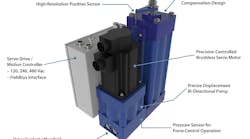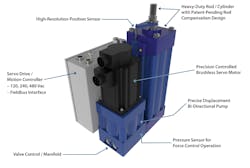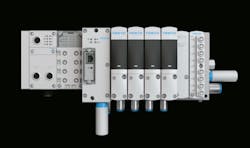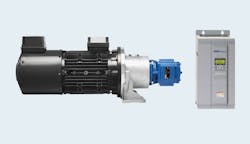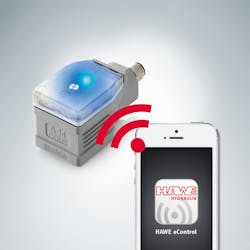The recent push to make everything smart or connected has led to some interesting evolutions in manufacturing. Application and infrastructure divided the use of electromechanical and fluid power. However, with the development of high-speed controls, quick-response motors, and improved software, variable-speed electric drives are finding their way into power hydraulic pumps.
Previously these technologies were difficult to combine. Over the last few years, there have been more motor-pump combinations able to provide power and responsiveness to match systems controlled by electrohydraulic valves or a variable-displacement pump. The result is not only new features and control but also a reduction in energy consumption.
While smart fluid systems sound new, they have been around for years. What is changing is how smarter they are becoming. It was inevitable with advancing technology, or perhaps the skills gap in the fluid power community, but an intelligent innovation has been triggered by blending electromechanical with hydraulic and/or pneumatic. These new solutions tend to be easy to program and control in a turnkey product. Moving forward, these variable-drive, electromechanical hydraulic, smart, all-in-one solutions might become the new norm.
“Traditionally, constant-speed AC induction motors have been used to drive the pumps in stationary hydraulic systems, with hydraulic power controlled by flow and pressure-regulating valves or a variable-displacement pump,” says Ray Scroggins, a contributing editor for Machine Design’s sister publication Power & Motion.
“However, the constantly-running motor can consume as much as 50% of full-load current, even when the system is not under load. In addition, pumps and motors in conventional hydraulic power units (HPUs) often are oversized to meet maximum duty-cycle demands.
“By contrast, a variable-frequency drive or servo-drive can manage an electric motor’s operating torque and speed more efficiently,” Scroggins continues. “Instead of running continuously at full speed, the motor rotates only fast enough to meet system demand at any given time.”
Although variable-speed drives commonly are paired with fixed-displacement pumps, additional benefits can come from teaming a variable-speed drive with a variable-displacement pump in many applications.
“By combining a variable-speed electric drive and a variable-displacement hydrostatic drive, we can drastically reduce the motor size, which lowers both installation costs and electrical parasitic losses,” says Rashid Aidun, application engineer—VAS team, Parker Hannifin.
“Combining a high-response variable-displacement pump with a VFD-controlled induction motor results in greater efficiency and a much higher system response than a variable-speed unit alone,” adds Paul Stavrou, manager of system applications, Bosch Rexroth.
“Using a variable-displacement piston pump makes it possible to adjust pressure, pump displacement, and motor speed (torque and speed) to optimal working points, thereby minimizing electric, hydraulic, and mechanical losses.”
What follows is a summary of major variable-speed drives and systems currently available:
Smart Pneumatics
One pneumatic solution with scalability, modularity, and greater control is Festo’s VTEM Motion Terminal. A scalable modular cyber-physical system (CPS) that digitizes pneumatics, the VTEM currently offers about 10 out of 50 planned apps. A single intelligent valve slice potentially provides the functionality of up to 50 individual components, reducing hardware and streamlining programming.
Design accounts for approximately 25 to 30% of the total cost. A CPS enables significant time gains and savings compared with a conventional valve terminal platform. In some cases, the time saved compared with designing and parameterizing a modular valve terminal and additional individual components is up to 70%.
The motion terminal’s integrated processor coordinates the actions of sensors, pilot, and poppet valves based on application algorithms. Changing an app modifies the interactions of the individual components and gives the intelligent valve its flexibility. Internal pressure measurement sensors simplify configuration and provide diagnostic functionality. VTEM Motion Terminals are provided in either four or eight-valve platforms.
These all-in-one modular scalable products not only reduce operational and design costs but make integration easier and increase flexibility. Fluid power is known for leaks; new technology can offer feedback with leakage diagnostics. New systems can offer precision positioning that can lead to features like Festo’s soft stop app.
By adding a position sensor and downloading the app, designers can shorten cycle times by up to 70%. The soft stop app can allow actuators to operate at high speeds but slow down before slamming into a shock absorber. This not only reduces vibration and cycle time but can increase the life of an actuator by reducing wear.
Smart Hydraulics
Bosch Rexroth, Charlotte, N.C., officials say its Sytronix variable-speed pump drives help to reduce energy consumption and operational noise. The hydraulic control intelligence is integrated directly into the electrical drive to adapt the motor torque to the machine’s pressure and flow-rate requirements. If the system does not require full power, the control automatically reduces the torque of the pump drive, which decreases energy consumption and noise. Practical application has shown that energy savings of up to 80% can be realized with Sytronix systems.
Bosch Rexroth’s Sytronix FcP drive systems are preferred for constant-pressure power units in the low power range. They include an induction-rated motor, a hydraulic pump, and an EFC electronic variable-frequency drive as an assembly.
The FcP runs at a lower power range consistent with PGF internal gear pumps. In higher pressure and power ranges, the FcP may use internal gear pumps from the company’s PGH family or its A10 or A4axial piston pumps. The torque and load on the electric motor are reduced by using variable pumps, especially in high power ranges, so that smaller drive sizes can be used.
The company’s Sytronix DRn drive systems are appropriate for constant-pressure power unit applications in the medium- and high-power ranges. The DRn system consists of a drive pump module with an asynchronous motor and a frequency converter as the control unit. DRn pressure control systems feature programming that monitors load demands and automatically adjusts the speed at constant pressure.
Easy-to-integrate, out-of-the-box solutions are popular in many applications, including metal forming, injection molding, die-casting, gas and steam turbines, and wind turbine pitch control. Among the solutions currently offered:
MJC Engineering, Huntington Beach, Calif., has created a turnkey solution that includes system integration, engineering, software technology, and programming under the Green Hydraulic Power (GHP) label. The system incorporates a Siemens Sinamics variable-speed drive powering an internal-gear hydraulic pump. MJC claims up to 70% energy savings over conventional hydraulic systems, as well as noise reduction by 20 dBA, less heat generation, lower cooling requirements, less oil volume, and a smaller footprint.
Parker Hannifin Corp., Cleveland, offers its Drive Controlled Pump (DCP) technology through its Hydraulic Pump and Power Systems Div., Columbus, Ohio. The DCP provides a synergistic approach that integrates hydraulic power units, electronic drives, electric motors, and hydraulic pumps to meet each local load demand within a hydraulic system. The product line integrates an AC drive unit, which includes variable frequency drives and electronics, and either an induction or servo motor, matched to either a vane pump or axial piston pump, or a combination of the two technologies.
Eaton Corp., Eden Prairie, Minn., highlights the energy savings of its variable-speed-drive pump solutions for equipment in the machine building, manufacturing, oil & gas, and machine industries. A complete solution can include one or several of Eaton’s PVM or Hydrokraft variable-displacement piston pumps, or VMQ fixed-displacement vane pumps. When combined with the smart control of Eaton’s variable-speed PowerXL DG1 general-purpose drive or SPX 9000 high-performance drive, the system can match the precise load requirements of the duty cycle.
Moog Inc., East Aurora, N.Y., has a speed-controlled pump system that allows machine builders to lower energy consumption by 30% or more compared to conventional approaches. The Electrohydrostatic Pump Unit (EPU) is intended to combine the benefits of both hydraulic and electric actuation. The Moog EPU is at the heart of an electro hydrostatic actuation system and helps make the decentralized drive system possible. Doing so eliminates the need for associated piping to reduce the overall machine footprint. The compact design of the EPU lets users mount it directly onto a cylinder, thereby reducing space requirements on each motion axis even more.
The trends of servo-motors and decentralized controls may have helped spawn these solutions. Now with feedback and sensors, these solutions are in line with the IoT and connected trends. With smart hydraulics, manufacturers can have power-dense, precise programable systems that can be controlled from anywhere in the world.
With the increase in smart and connected products on the market manufacturers have the ability to find turnkey solutions that are easy to integrate, operate, and change. In addition, there are myriad other connected valves, gages, and decentralized controls if an out-of-the-box solution doesn’t meet your demands.










